Southern Cross University COM00207: Mini Essay on Communication
VerifiedAdded on 2022/09/26
|5
|1102
|25
Essay
AI Summary
This essay explores the critical role of communication within an organizational context, differentiating between verbal and non-verbal communication methods. The author emphasizes the significance of effective communication for a business manager, highlighting its impact on information transmission and comprehension. Drawing on personal experience, the essay presents a case study from a previous workplace, illustrating how non-verbal cues, such as body language and demeanor, are assessed during the hiring process. The author discusses the importance of maintaining communication skills during interviews, including eye contact, facial expressions, and posture. The essay concludes by reflecting on the complexities of organizational culture and the importance of communication skills for employees and management alike, stressing the value of diverse interactions and training in communication theories.
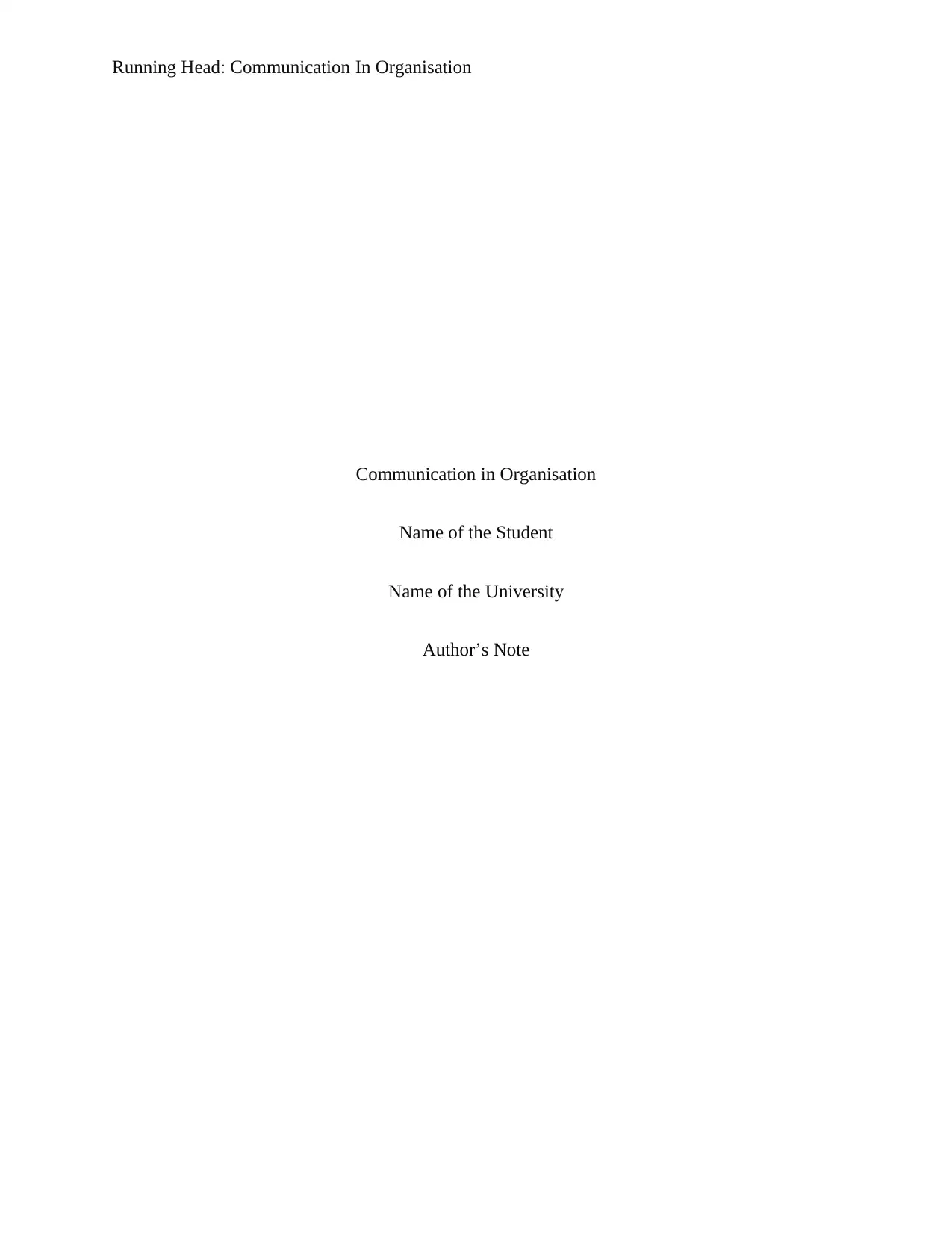
Running Head: Communication In Organisation
Communication in Organisation
Name of the Student
Name of the University
Author’s Note
Communication in Organisation
Name of the Student
Name of the University
Author’s Note
Paraphrase This Document
Need a fresh take? Get an instant paraphrase of this document with our AI Paraphraser
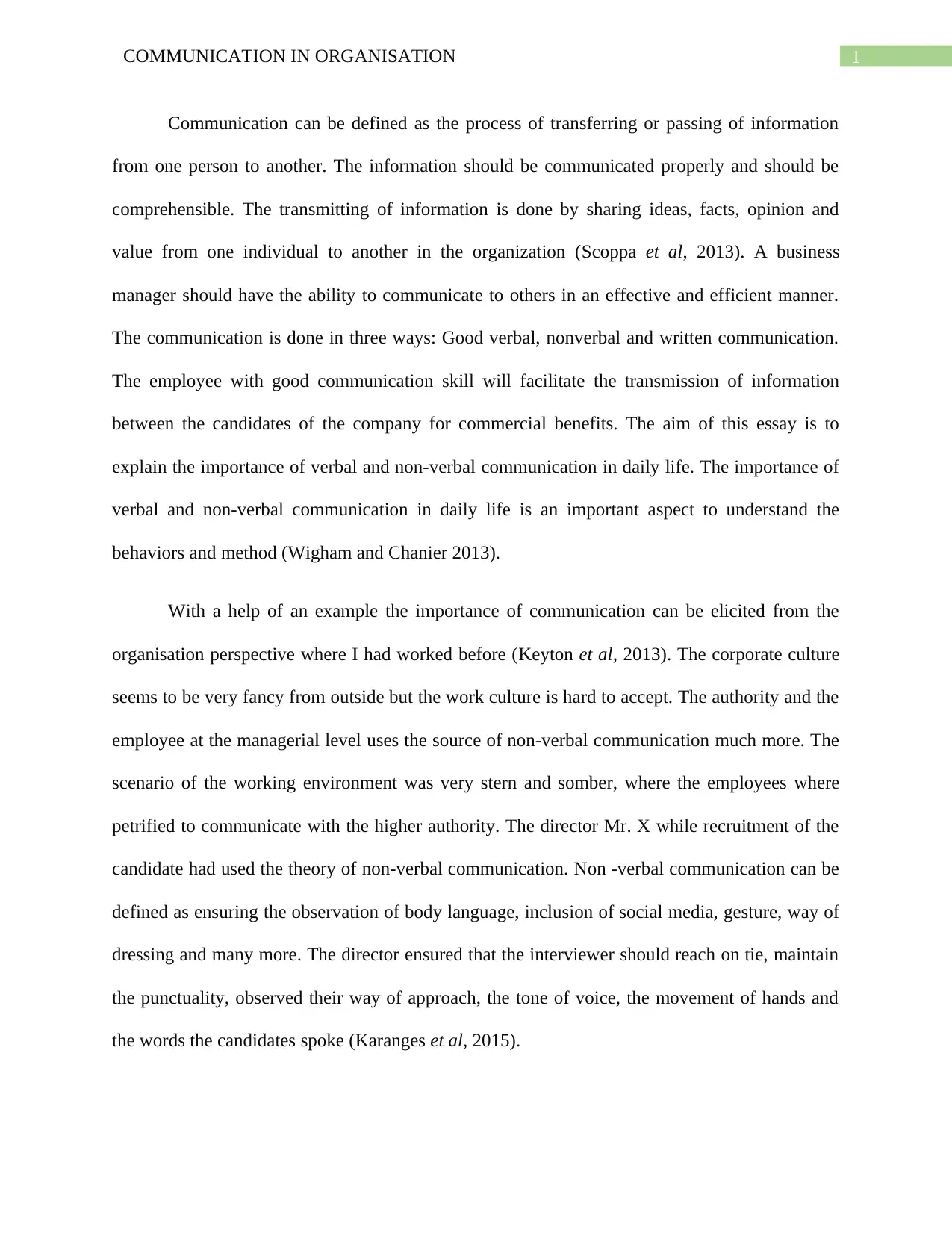
1COMMUNICATION IN ORGANISATION
Communication can be defined as the process of transferring or passing of information
from one person to another. The information should be communicated properly and should be
comprehensible. The transmitting of information is done by sharing ideas, facts, opinion and
value from one individual to another in the organization (Scoppa et al, 2013). A business
manager should have the ability to communicate to others in an effective and efficient manner.
The communication is done in three ways: Good verbal, nonverbal and written communication.
The employee with good communication skill will facilitate the transmission of information
between the candidates of the company for commercial benefits. The aim of this essay is to
explain the importance of verbal and non-verbal communication in daily life. The importance of
verbal and non-verbal communication in daily life is an important aspect to understand the
behaviors and method (Wigham and Chanier 2013).
With a help of an example the importance of communication can be elicited from the
organisation perspective where I had worked before (Keyton et al, 2013). The corporate culture
seems to be very fancy from outside but the work culture is hard to accept. The authority and the
employee at the managerial level uses the source of non-verbal communication much more. The
scenario of the working environment was very stern and somber, where the employees where
petrified to communicate with the higher authority. The director Mr. X while recruitment of the
candidate had used the theory of non-verbal communication. Non -verbal communication can be
defined as ensuring the observation of body language, inclusion of social media, gesture, way of
dressing and many more. The director ensured that the interviewer should reach on tie, maintain
the punctuality, observed their way of approach, the tone of voice, the movement of hands and
the words the candidates spoke (Karanges et al, 2015).
Communication can be defined as the process of transferring or passing of information
from one person to another. The information should be communicated properly and should be
comprehensible. The transmitting of information is done by sharing ideas, facts, opinion and
value from one individual to another in the organization (Scoppa et al, 2013). A business
manager should have the ability to communicate to others in an effective and efficient manner.
The communication is done in three ways: Good verbal, nonverbal and written communication.
The employee with good communication skill will facilitate the transmission of information
between the candidates of the company for commercial benefits. The aim of this essay is to
explain the importance of verbal and non-verbal communication in daily life. The importance of
verbal and non-verbal communication in daily life is an important aspect to understand the
behaviors and method (Wigham and Chanier 2013).
With a help of an example the importance of communication can be elicited from the
organisation perspective where I had worked before (Keyton et al, 2013). The corporate culture
seems to be very fancy from outside but the work culture is hard to accept. The authority and the
employee at the managerial level uses the source of non-verbal communication much more. The
scenario of the working environment was very stern and somber, where the employees where
petrified to communicate with the higher authority. The director Mr. X while recruitment of the
candidate had used the theory of non-verbal communication. Non -verbal communication can be
defined as ensuring the observation of body language, inclusion of social media, gesture, way of
dressing and many more. The director ensured that the interviewer should reach on tie, maintain
the punctuality, observed their way of approach, the tone of voice, the movement of hands and
the words the candidates spoke (Karanges et al, 2015).
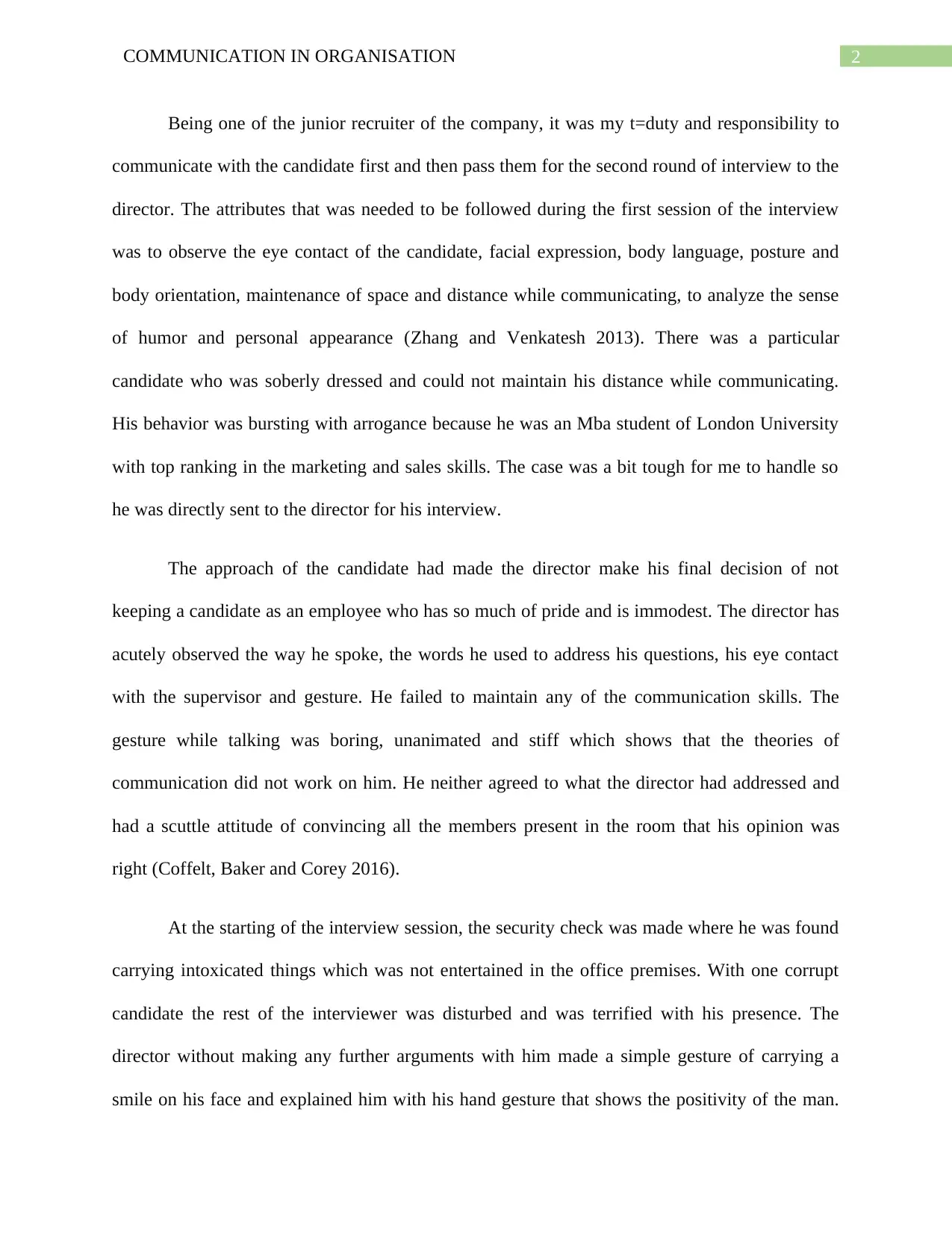
2COMMUNICATION IN ORGANISATION
Being one of the junior recruiter of the company, it was my t=duty and responsibility to
communicate with the candidate first and then pass them for the second round of interview to the
director. The attributes that was needed to be followed during the first session of the interview
was to observe the eye contact of the candidate, facial expression, body language, posture and
body orientation, maintenance of space and distance while communicating, to analyze the sense
of humor and personal appearance (Zhang and Venkatesh 2013). There was a particular
candidate who was soberly dressed and could not maintain his distance while communicating.
His behavior was bursting with arrogance because he was an Mba student of London University
with top ranking in the marketing and sales skills. The case was a bit tough for me to handle so
he was directly sent to the director for his interview.
The approach of the candidate had made the director make his final decision of not
keeping a candidate as an employee who has so much of pride and is immodest. The director has
acutely observed the way he spoke, the words he used to address his questions, his eye contact
with the supervisor and gesture. He failed to maintain any of the communication skills. The
gesture while talking was boring, unanimated and stiff which shows that the theories of
communication did not work on him. He neither agreed to what the director had addressed and
had a scuttle attitude of convincing all the members present in the room that his opinion was
right (Coffelt, Baker and Corey 2016).
At the starting of the interview session, the security check was made where he was found
carrying intoxicated things which was not entertained in the office premises. With one corrupt
candidate the rest of the interviewer was disturbed and was terrified with his presence. The
director without making any further arguments with him made a simple gesture of carrying a
smile on his face and explained him with his hand gesture that shows the positivity of the man.
Being one of the junior recruiter of the company, it was my t=duty and responsibility to
communicate with the candidate first and then pass them for the second round of interview to the
director. The attributes that was needed to be followed during the first session of the interview
was to observe the eye contact of the candidate, facial expression, body language, posture and
body orientation, maintenance of space and distance while communicating, to analyze the sense
of humor and personal appearance (Zhang and Venkatesh 2013). There was a particular
candidate who was soberly dressed and could not maintain his distance while communicating.
His behavior was bursting with arrogance because he was an Mba student of London University
with top ranking in the marketing and sales skills. The case was a bit tough for me to handle so
he was directly sent to the director for his interview.
The approach of the candidate had made the director make his final decision of not
keeping a candidate as an employee who has so much of pride and is immodest. The director has
acutely observed the way he spoke, the words he used to address his questions, his eye contact
with the supervisor and gesture. He failed to maintain any of the communication skills. The
gesture while talking was boring, unanimated and stiff which shows that the theories of
communication did not work on him. He neither agreed to what the director had addressed and
had a scuttle attitude of convincing all the members present in the room that his opinion was
right (Coffelt, Baker and Corey 2016).
At the starting of the interview session, the security check was made where he was found
carrying intoxicated things which was not entertained in the office premises. With one corrupt
candidate the rest of the interviewer was disturbed and was terrified with his presence. The
director without making any further arguments with him made a simple gesture of carrying a
smile on his face and explained him with his hand gesture that shows the positivity of the man.
⊘ This is a preview!⊘
Do you want full access?
Subscribe today to unlock all pages.

Trusted by 1+ million students worldwide
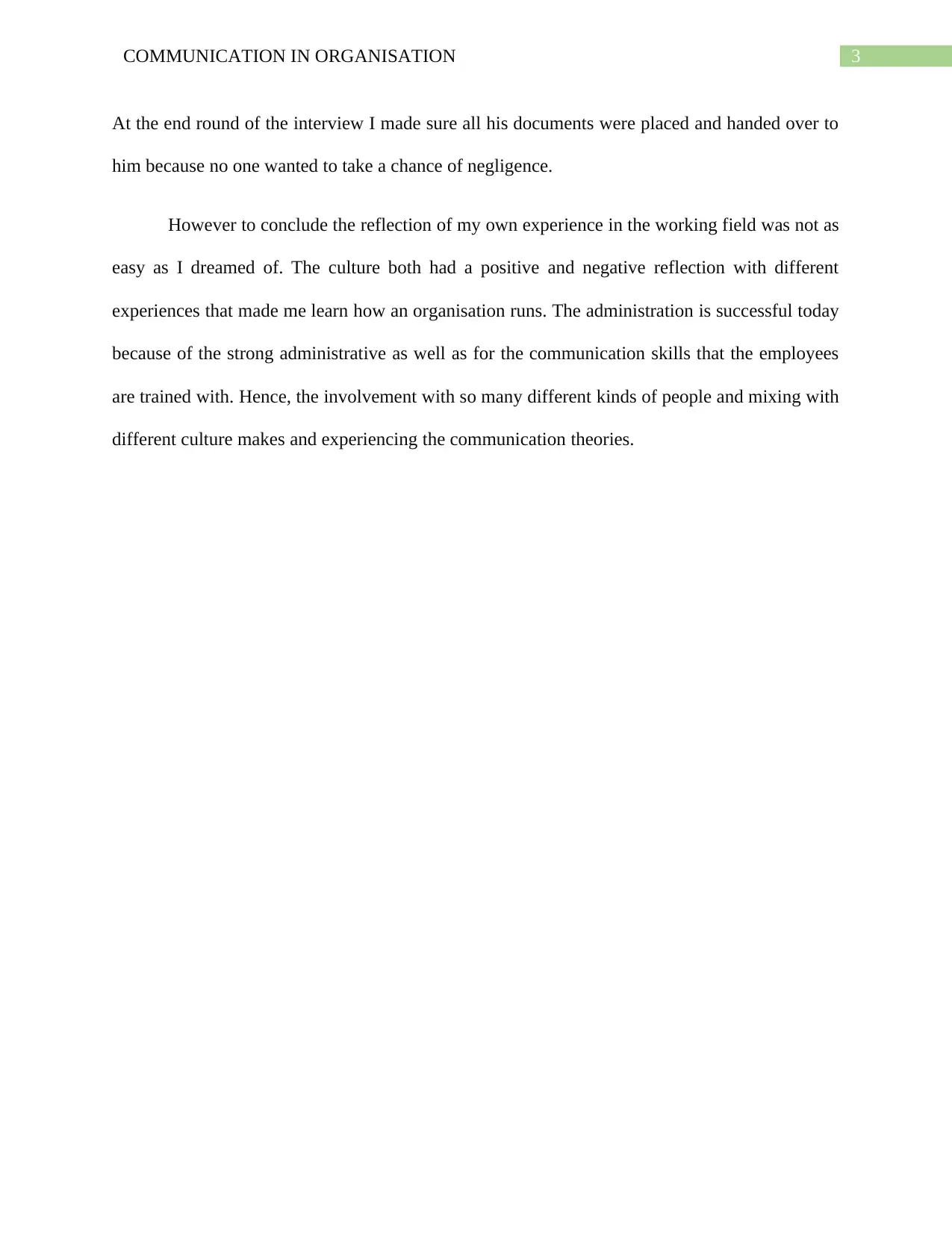
3COMMUNICATION IN ORGANISATION
At the end round of the interview I made sure all his documents were placed and handed over to
him because no one wanted to take a chance of negligence.
However to conclude the reflection of my own experience in the working field was not as
easy as I dreamed of. The culture both had a positive and negative reflection with different
experiences that made me learn how an organisation runs. The administration is successful today
because of the strong administrative as well as for the communication skills that the employees
are trained with. Hence, the involvement with so many different kinds of people and mixing with
different culture makes and experiencing the communication theories.
At the end round of the interview I made sure all his documents were placed and handed over to
him because no one wanted to take a chance of negligence.
However to conclude the reflection of my own experience in the working field was not as
easy as I dreamed of. The culture both had a positive and negative reflection with different
experiences that made me learn how an organisation runs. The administration is successful today
because of the strong administrative as well as for the communication skills that the employees
are trained with. Hence, the involvement with so many different kinds of people and mixing with
different culture makes and experiencing the communication theories.
Paraphrase This Document
Need a fresh take? Get an instant paraphrase of this document with our AI Paraphraser
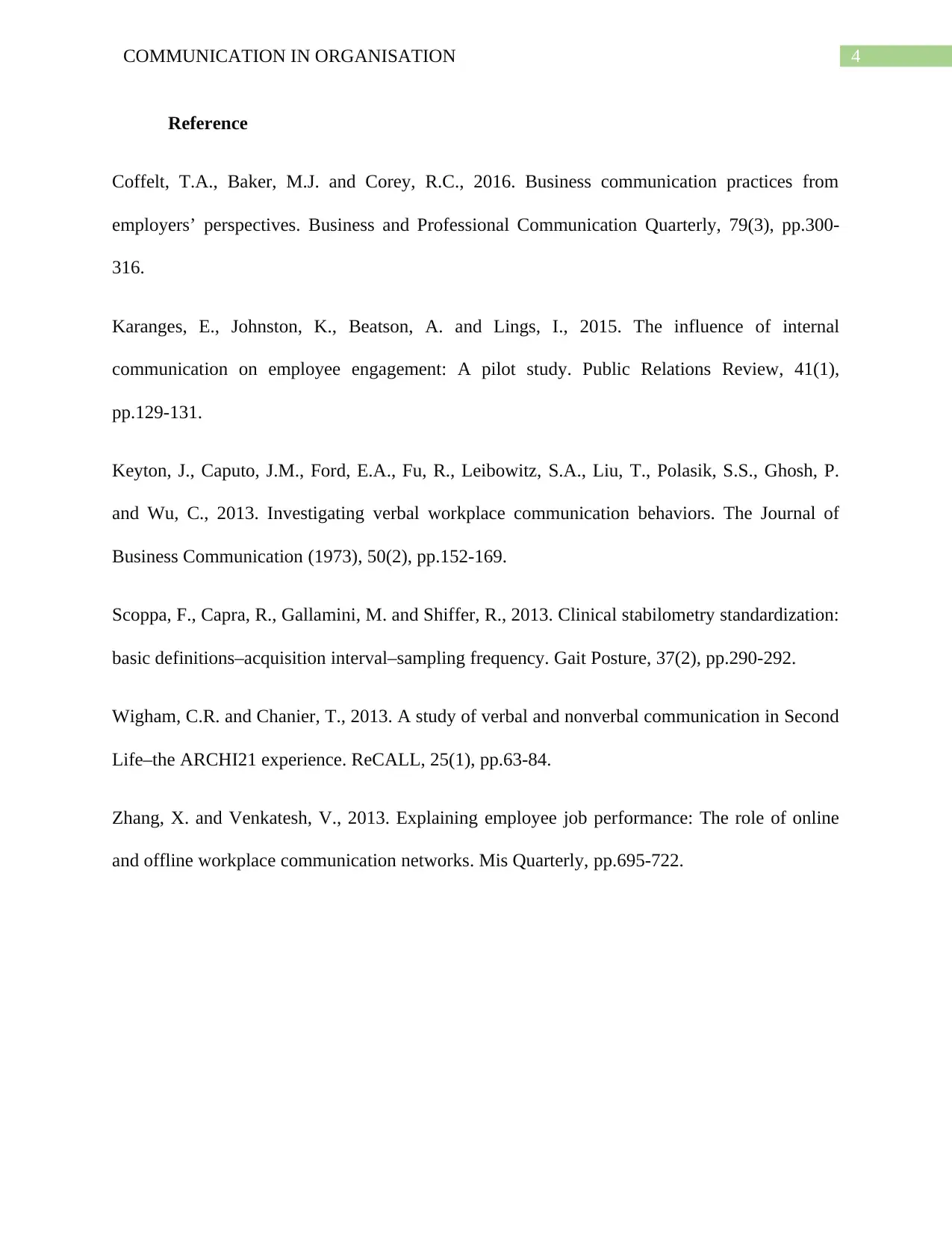
4COMMUNICATION IN ORGANISATION
Reference
Coffelt, T.A., Baker, M.J. and Corey, R.C., 2016. Business communication practices from
employers’ perspectives. Business and Professional Communication Quarterly, 79(3), pp.300-
316.
Karanges, E., Johnston, K., Beatson, A. and Lings, I., 2015. The influence of internal
communication on employee engagement: A pilot study. Public Relations Review, 41(1),
pp.129-131.
Keyton, J., Caputo, J.M., Ford, E.A., Fu, R., Leibowitz, S.A., Liu, T., Polasik, S.S., Ghosh, P.
and Wu, C., 2013. Investigating verbal workplace communication behaviors. The Journal of
Business Communication (1973), 50(2), pp.152-169.
Scoppa, F., Capra, R., Gallamini, M. and Shiffer, R., 2013. Clinical stabilometry standardization:
basic definitions–acquisition interval–sampling frequency. Gait Posture, 37(2), pp.290-292.
Wigham, C.R. and Chanier, T., 2013. A study of verbal and nonverbal communication in Second
Life–the ARCHI21 experience. ReCALL, 25(1), pp.63-84.
Zhang, X. and Venkatesh, V., 2013. Explaining employee job performance: The role of online
and offline workplace communication networks. Mis Quarterly, pp.695-722.
Reference
Coffelt, T.A., Baker, M.J. and Corey, R.C., 2016. Business communication practices from
employers’ perspectives. Business and Professional Communication Quarterly, 79(3), pp.300-
316.
Karanges, E., Johnston, K., Beatson, A. and Lings, I., 2015. The influence of internal
communication on employee engagement: A pilot study. Public Relations Review, 41(1),
pp.129-131.
Keyton, J., Caputo, J.M., Ford, E.A., Fu, R., Leibowitz, S.A., Liu, T., Polasik, S.S., Ghosh, P.
and Wu, C., 2013. Investigating verbal workplace communication behaviors. The Journal of
Business Communication (1973), 50(2), pp.152-169.
Scoppa, F., Capra, R., Gallamini, M. and Shiffer, R., 2013. Clinical stabilometry standardization:
basic definitions–acquisition interval–sampling frequency. Gait Posture, 37(2), pp.290-292.
Wigham, C.R. and Chanier, T., 2013. A study of verbal and nonverbal communication in Second
Life–the ARCHI21 experience. ReCALL, 25(1), pp.63-84.
Zhang, X. and Venkatesh, V., 2013. Explaining employee job performance: The role of online
and offline workplace communication networks. Mis Quarterly, pp.695-722.
1 out of 5
Related Documents
Your All-in-One AI-Powered Toolkit for Academic Success.
+13062052269
info@desklib.com
Available 24*7 on WhatsApp / Email
![[object Object]](/_next/static/media/star-bottom.7253800d.svg)
Unlock your academic potential
Copyright © 2020–2025 A2Z Services. All Rights Reserved. Developed and managed by ZUCOL.



